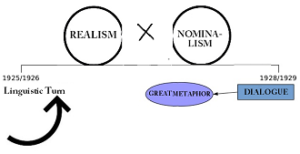
Between the essence and the Being
Although dualism remains present, the essence is conceived by analogy to Being, and this was also the Thomist doctrine, it remained an onto-theology until the 20th century, it took a whole path of phenomenology to encounter the Other, the non – Being not as a contradiction, and the end of the dualism between Being and essence.
Being, and this was also the Thomist doctrine, it remained an onto-theology until the 20th century, it took a whole path of phenomenology to encounter the Other, the non – Being not as a contradiction, and the end of the dualism between Being and essence.
The long discussion of the medieval period between realists and nominalists was based on a term now unknown which was quididade, which means that thing is, from Greek hylé to modern models of Heidegger’s metaphysics, where the thing that can be material or not, and also what we think about it, in Husserl’s line there is only awareness of something, or of the thing.
But there was a philosopher in the Middle Ages, Duns Scotto (1266-1308) who did not distinguish between the thing that exists (si est) and what it is (quid est), and theologically it was complicated because the thesis of Santo Tomás de Aquino it was by analogy, that is, the meaning of similarity between things or facts (Houaiss dictionary, 2009, p. 117), and the religious were always in a hurry because in the 20th century Duns Scotto was accepted within the Catholic Christian doctrine, becoming blessed (John Paul II declared it).
His theory of knowledge used the two known distinctions distinctio realis (real distinction) and exists between two beings of nature, and the distinction rationalis (distinction of reason) that occurs between two beings, but in the mind of the subject who knows, but breaks dualism in creating a third possibility to distinctio formalis (formal distinction) that occurs in the perceived entity and is neither real nor in the mind.
So in addition to his disciple William de Ockham, famous for the simplification principle called Ockham’s Razor, but in a way Descartes, Leibniz, Hobbes and Kant had their influence.
However, the recovery of Duns Scotto is essential to overcome the dualism of nominalism / realism and the overcoming of pure realism by philosophical hermeneutics, and thus also the modern correspondent of nominalism, which is the linguistic turn, makes sense and opens up dialogue.









